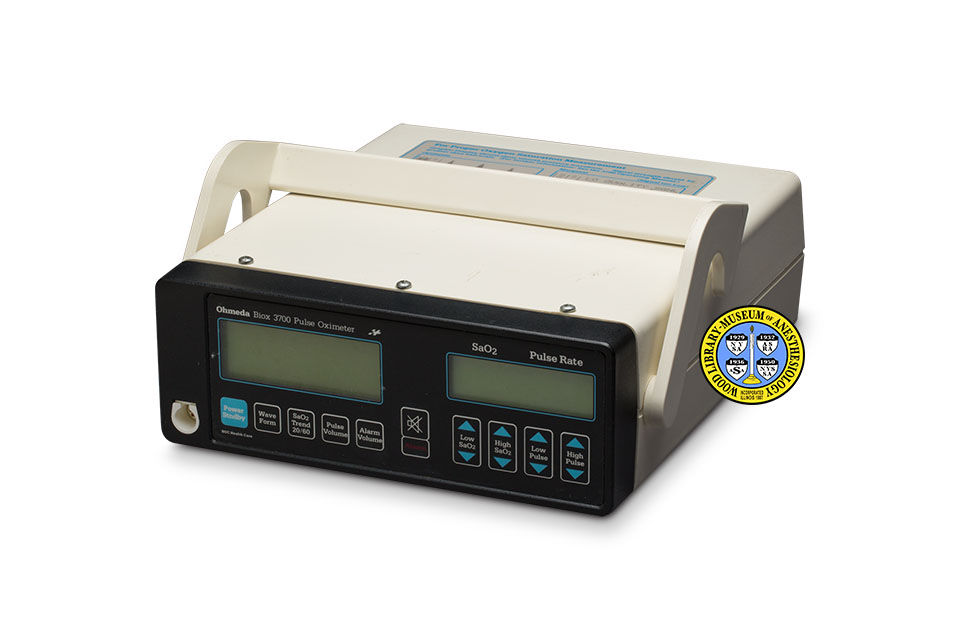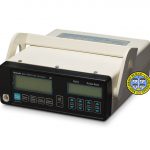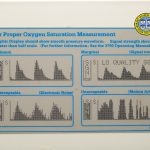Ohmeda Biox 3700
Anesthesiologists are responsible for maintaining the surgical patient's vital functions, including respiration. The amount of oxygen in the patient's blood is an indicator of how well he or she is breathing. Measurement of the oxygen in a sample of blood is called arterial blood gas sampling, abbreviated SaO2. Pulse oximeters use light waves to measure blood oxygenation through the patient's skin. This noninvasive measurement, called arterial oxyhemoglobin saturation, abbreviated SpO2, was first described in 1974.
Mr. Scott A. Wilber is credited with inventing the first apparatus to use SpO2 technology. In 1979, Wilber co-founded Biox Technology, Inc., in Boulder, Colorado. The company's pulse oximeters were originally marketed for use by respiratory therapists; they also quickly came into use by anesthesiologists. In 1984, Biox Technology became part of the Ohmeda division of British Oxygen Co.
Mr. Wilber then developed the Ohmeda Biox 3700 pulse oximeter. It could display both numeric and graphic representations of the patient's SpO2 and pulse rate at a given moment, as well as the changes in SpO2 over the past hour. It had ear probe and finger probe sensors for adult patients, as well as smaller sensors for children and infants. It was also equipped with both visual and audible alarms, and a reserve battery. While Ohmeda soon introduced newer models, the 3700 continued in clinical use for decades.
Catalog Record: Ohmeda Biox 3700 55. Ohmeda Biox 3700
Access Key: aqta
Accession No.: 2007-05-10-2 O
Title: Ohmeda Biox 3700 / Ohmeda.
Author: Scott A. Wilber.
Corporate Author: Ohmeda.
Title variation: Alt Title
Title: Ohmeda pulse oximeter.
Publisher: Boulder, Colorado : Ohmeda, [between 1989 and 1990].
Physical Description: 1 pulse oximeter : plastics, metals ; 19 x 28 x 293 cm.
Subject: Blood Gas Monitoring, Transcutaneous – instrumentation.
Subject: Oximetry – instrumentation.
Subject: Oxygen – analysis.
Subject: Oxygen – instrumentation.
Subject: Pulse – instrumentation.
Note Type: General
Notes: The title was taken from the object. The approximate date of manufacture also was taken from the object label: “3 Year Warrantee Begins February 1990”. Described from the user’s perspective.
Note Type: Citation
Notes: Cecil WT, Thorpe KJ, Fibuch EE, Tuohy GF. A clinical evaluation of the accuracy of the Nellcor N-100 and Ohmeda 3700 pulse oximeters. J Clinical Monitoring. January, 1988;4(1):31-36.
Note Type: Citation
Notes: Ohmeda Company File. Archives. Located at: Wood Library-Museum of Anesthesiology, Schaumburg, Illinois.
Note Type: Citation
Notes: Priest WC. Re problems with the Ohmeda-Biox 3100 pulse oximeter. Revised February 10, 2007. https://www.electronicspoint.com/threads/re-problems-with-ohmeda-biox-3100-pulse-oximeter.73687/. Accessed July 10, 2018.
Note Type: Citation
Notes: Warley ARH, Mitchell JH, Stradling JR. Evaluation of the Ohmeda 3700 pulse oximeter. Thorax. November, 1987;42(11):892-896.
Note Type: Citation
Notes: Wikipedia.org. https://en.wikipedia.org/wiki/Biox. Accessed July 10, 2018.
Note Type: Citation
Notes: Wilber SA, inventor; Biox Technology, Inc., assignee. Blood constituent measuring device and method. U. S. patent 4,407,209. October 4, 1981.
Note Type: Physical Description
Notes: One pulse oximeter; Consists of a rectangular ivory and black plastic housing with adjustable handle and integrated power cord; The handle can be used either to carry the unit or swiveled under the housing to act as a stand; The dimensions in the short physical description are those with the handle positioned as a stand, and the power cord fully extended;
The front of the unit has two banks of components; That bank on the left consists of a display with a row of membrane buttons below it; These buttons are labeled, from left to right: “Power Standby”, “Wave Form”, “SaO2 Trend 20/60”, “Pulse Volume” and “Alarm Volume”; To the left of these buttons there is an electronic port for a nine pin plug; Above this bank the unit is marked: “Ohmeda Biox 3700 Pulse Oximeter”; That bank on the left consists of a smaller display, with a row of four membrane buttons below it; These buttons are labeled, from left to right: “Low SaO2”, “High SaO2”, “Low Pulse” and “High Pulse”; Above this bank, the unit is marked “SaO2 Pulse Rate”; Between these two banks there is a single membrane button labeled “Alarm”;
An adhesive label on the top of the unit reads: “For Proper Oxygen Saturation Measurement [new line] Graphic display should show smooth pressure waveform. Signal strength should be greater than half scale. (For further information: See the 3799 Operating Manual.)”; Below this there are four representative graphs, labeled “Optimum”, “Marginal (Signal too Low)”, “Unacceptable (Electronic Noise)” and “Unacceptable (Motion Artifact)”; There are no markings on the left or right sides of the housing;
Components on the back of the unit comprise a jack marked “Pulse Rate”, a jack marked “SaO2”, a jack for a 25-pin plug marked “Digital Interface”, and the power cord; To the left of these components the back is marked, from top to bottom: “! Warning: Explosion Hazard. Do not use in presence of flammable anesthetics”; “! Warning: For continued protection against fire hazard replace only with same type and rating of fuse”; and “! Caution: Electrical Shock Hazard. Do not remove cover. Refer servicing to qualified service personnel.”; To the right of these warnings there is an adhesive label reads, in part: “Ohmeda [new line] Louisville CO 80027 [new line] 3 Year Warrantee Begins February 1990”; The power cord is fastened to the right of these plugs; Below the plug it is marked: “Use hospital grade grounded receptacle 50/60 Hz”; To the right of the power cord the back is marked: “Ohmeda Biox [new line] 3700 Pulse Oximeter [new line] 50/60 Hz 30VA Max. [new line] Serial Number FMAS02106 [new line] U. S. Patents: 4394572, 4407290 [new line] Other Pat. Pend. [new line] “[logo of Underwriters Laboratories] 84G8[new line] Listed [new line] Medical Equipment 1000-129”; Below this it is marked: “Ohmeda [new line] Louisville CO 80027 [new line] A Division of The BOC Group Inc. [new line] BOC Health Care”;
An adhesive label on the bottom of the unit reads: “Ohmeda [new line] Traceability registered with Ohmeda in compliance with the 1976 Medical device Legislation [new line] Attach this to bottom of unit [new line] BOC Health Care”.
Note Type: Reproduction
Notes: Photographed by Mr. Steve Donisch, January 15, 2018.
Note Type: Acquisition
Notes: Gift of Bradley E. Smith, M.D.
Note Type: Historical
Notes: Anesthesiologists are responsible for monitoring and maintaining the surgical patient’s respiration. The amount of oxygen in the patient’s blood is an excellent indicator of how well he or she is breathing. Measurement of the oxygen in a sample of blood drawn from the patient is called arterial blood gas sampling, abbreviated SaO2. Noninvasive pulse oximeters use light waves to measure blood oxygenation through the patient’s skin. The measurement called arterial oxyhemoglobin saturation, abbreviated SpO2, was first described in 1974 by Japanese researcher Takuo Aoyagi.
Mr. Scott A. Wilber is credited with inventing the first apparatus to use this noninvasive technology. In 1979, partners Michael Hickey, Bill Moe and Wilber founded Biox Technology, Inc., in Boulder, Colorado. The company’s products were originally marketed for use by respiratory therapists; they also quickly came into use by anesthesiologists. A direct competitor to Biox, Nellcor, was formed in 1981. Nellcor’s first pulse oximeter, the N-100, was introduced two years later.
Biox was acquired by the British Oxygen Corp. (BOC) in 1984, and merged with BOC’s Ohmeda Health Care division. Mr. Wilber then developed the Ohmeda Biox 3700. It could display both numeric and graphic representations of the patient’s SpO2 and pulse rate at a given moment, as well as the changes in SpO2 (called the trend) for either the past 20 minutes or past 60 minutes. It had ear probe and finger probe sensors for adult patients, as well as smaller sensors for pediatric and neonatal patients. It was also equipped with both visual and audible alarms, and a reserve battery. It is notable that the apparatus itself, and Ohmeda’s product literature, state that the 3700 measured “SaO2”, while in fact this is a noninvasive monitor which measures SpO2.
Ohmeda introduced several newer models of the Biox over the next few years. In 1988, Ohmeda was acquired by the Finish company, Instrumentarium Corporation, and became Datex-Ohmeda. The cataloger’s review of the medical literature found references to continuing clinical use of the model 3700 into the first decade of the 21st Century.
Note Type: Exhibition
Notes: Selected for the WLM website.



